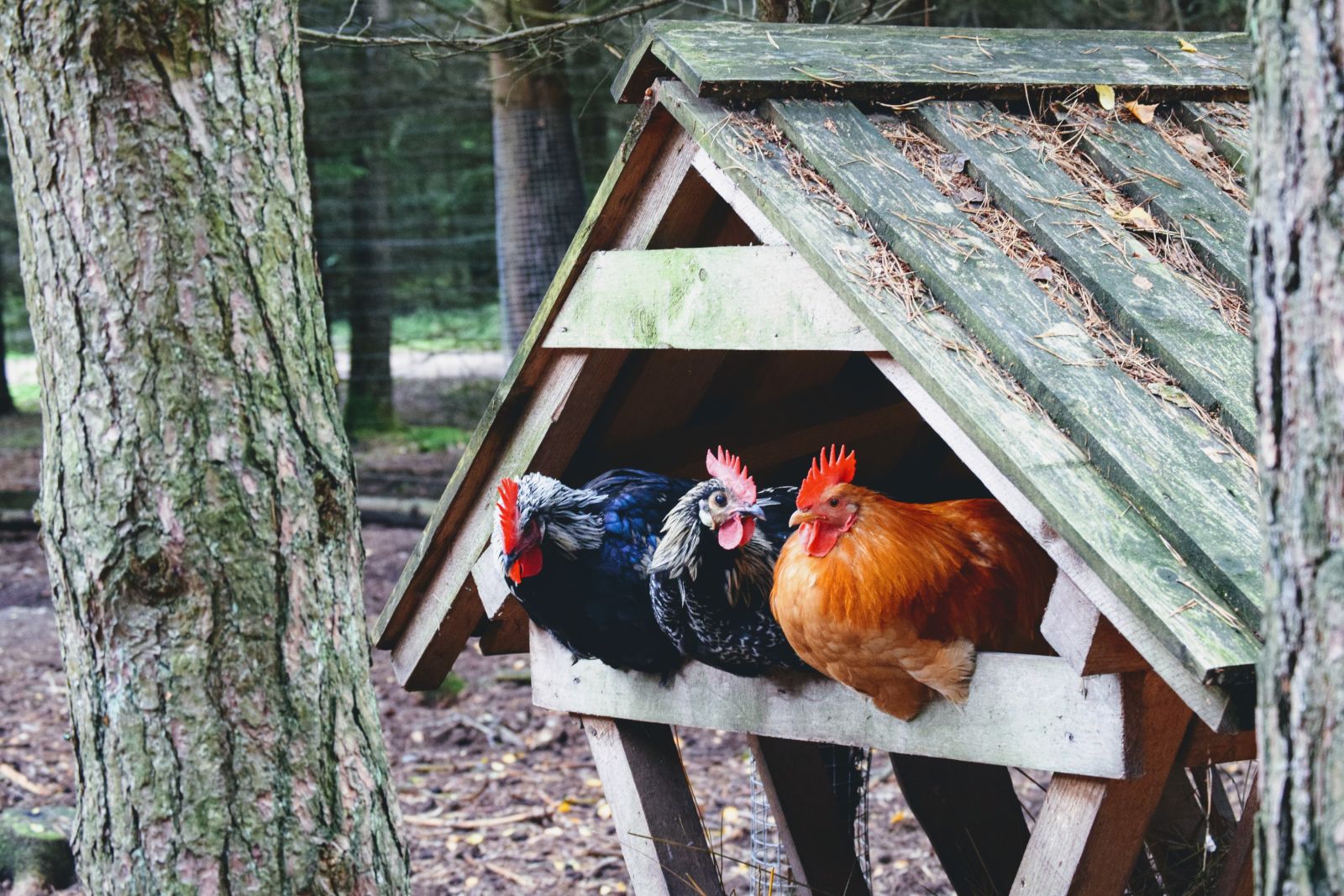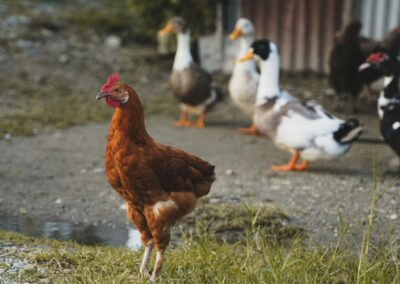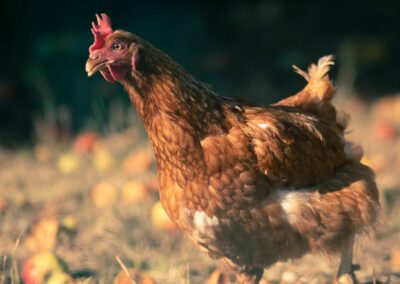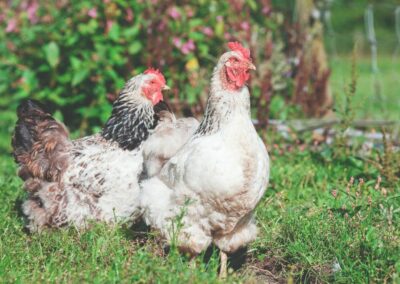Whether you own chickens or are toying with the concept of raising some for self-sufficiency purposes, at some point, building a henhouse or a coop might have crossed your mind. The idea of growing your own food and being self-sufficient seems attractive, but what most people do not know is there are so many aspects to take into account, and building a coop is just one of those. In this article, we’ll talk about the things you must consider so you can build your own chicken coop. Read on.
1. How Many Chickens will Fit in your Coop?
The first and most important thing for you to consider is the size of your chicken coop. Ideally, you would want your chickens to have enough room to be comfortable and stay healthy but small enough to generate heat inside. This depends on the number of chickens you have or you intend to have, but for six chickens — which is usually the number of chickens most beginners start with — the right size would be 18 square feet. You can use this chicken coop calculator for a more personalized estimate.
When it comes to height, you should be able to stand inside to make it easy for you to gather eggs and shovel manure. It’s not fun to be hunching over when doing these things, so keep that in mind when considering the height.
Note about height: This is useless to consider if you don’t have the correct perches.
2. Mobile or Fixed Chicken Coop?
Now that you know how many chickens you can house in your coop, let’s talk about the two types of coop — fixed and mobile — and their advantages and disadvantages.
Fixed Chicken Coop Pros:
1. More stable. Since a fixed chicken coop will require a good foundation, it will allow for more stability and permanence. If built and placed strategically, the structure should be able to safely withstand strong winds, as well as all of the other climatic changes during all seasons.
2. Predator-proof. A fixed coop design makes it hard for predators to burrow into the ground and break inside the pen because of its sturdy construction. You won’t have to worry about your chickens at night with this type of well-made coop.
3. Good for small spaces. A fixed chicken coop is ideal for you if your backyard has only limited space because you don’t have to move it around, unlike a mobile coop.
Fixed Chicken Coop Cons:
1. High-maintenance. This depends on the kind of flooring you will use. Generally, because the chicken coop is permanent and chickens are likely to poop in the same place, you will need to sanitize your coop more often — also to prevent it from being smelly.
2. Parasites-prone. In connection with the first disadvantage, if the coop is not maintained properly, it can attract parasites that will start to infect your chickens. If not dealt with accordingly, the disease can easily develop and spread.
3. More costly. To ensure the durability of a permanent coop, it is essential to have a robust framework which means you need to buy as much lumber and other materials as needed to achieve this objective.
Mobile Chicken Coop Pros:
1. Great for bigger properties. Although a mobile coop is smaller than the fixed one, it is best for larger properties because you can transfer it from one place to another. Definitely suitable for chicken pasture rotation.
2. Free ranging. Another advantage of a portable coop is that it helps with rotating pastures, as mentioned, which means the chickens are less likely to destroy the property and quickly wear down the pasture.
3. Easier to clean. When the chickens poop, it falls straight to the ground and you can just move the chicken tractor around if you don’t have the time to clean it yet or if you plan to let the manure compost by itself.
Mobile Chicken Coop Cons:
1. Needs sturdy construction to withstand predators and weather. Because of the portability feature of the mobile coop, it’s designed to be light and easily carried, thus even the predators and strong wind can damage it freely. You have to move it somewhere safe at night when the predators are active.
2. Smaller, and not ideal for the long term. Usually, you can only store up to six chickens in a mobile coop. The reason for this is because if you make it any bigger, it’s going to be too heavy to move around which defeats the purpose of portability. Not a good option if you are planning to keep more chickens in the future.
3. Needs frequent checks if the bolts and screws are secured. It’s necessary to inspect the connectors and tighten these parts if needed after every move so the chicken tractor will last longer.
3. How Will You Clean and Gather Eggs From Your Chicken Coop?
The good rule of thumb is, you must be able to get inside with no issue and be able to stand without bumping your head on the ceiling. Make it accessible, you’ll thank yourself for considering this when it’s time for you to clean the coop and collect the eggs, depending on your coop type. Tidying up, in itself, already sounds laborious so you wouldn’t want to make it even more difficult than it seems.
One more thing to consider, will you build your coop on the ground floor or prefer to have it off the ground? If you ask around to people growing chickens, most would suggest the raised option.
An elevated coop is usually good if you will attach a run to it, as it’s easier to clean, prevents rodents from living underneath the coop, adds space on your run, and protects your flock from flood, if you are in such a flood-prone area. Also, for this type, you can build an egg access door to lessen the need to go inside the coop when gathering eggs.
4. What to Use as Chicken Coop Flooring?
Let’s take a closer look at some of the commonly used flooring.
Dirt
The dirt floor is inexpensive and can be odor-free as the waste is absorbed quickly — provided you place your coop in an area where the water doesn’t stagnate. However, dirt is not always advisable because of its negative sides; rodents can easily burrow into your coop, and the surface can wear out easily since your chickens will for sure scratch it.
Concrete
For long-lasting coop flooring, opt for a concrete choice. Other benefits of using concrete are that it’s predator-proof, easy to hose out, durable, and doesn’t rot, unlike wood. Along with the benefits, there are also disadvantages, however. Concrete flooring is expensive, can stink because the smell stays even after cleaning the coop, and the rough surface is precarious for your birds’ feet.
Wood
Wood is probably the most commonly used flooring type because it’s cheap, but it’s not always the best. The reason for this is, it’s hard to clean and it eventually rots, especially when termites get to it. However, when you’re just starting to raise chickens and you want to build a temporary small coop in a short period of time with a limited budget, wood is a good option.
Deep-litter bedding
Using a deep-litter bedding system has numerous advantages, including:
- Easier to manage. No need for you to shovel often or replace the bedding frequently.
- Provides warmth. Materials that are used for deep-litter bedding such as hay, pine shavings, sawdust and straw contain high carbon, and chickens’ waste consists of high nitrogen — when both elements combine, they produce heat that is beneficial for the flock.
- Odorless. Another wonderful advantage of using the materials mentioned is that they neutralize the smell of ammonia.
- Manure turns to automatic fertilizer without the need for your effort. Poop attracts good microbes whose purpose is to break down the feces, consume the bad bacteria from waste and leave the good bacteria behind, making the litter as healthy as possible. It’s an automatic decomposition process and you don’t have to do anything — except add more bedding as deemed necessary and occasionally mix it up to prevent the droppings from accumulating in one place. You’ll be left with nutritious fertilizer, which is amazing!
If you’re interested to know more about the dos and don’ts of the deep-litter bedding method, have a look at this article.
5. What to Put In the Chicken Coop
Perches
A perch or roost is defined by HGTV as, “an elevated bar, branch or narrow plank on which chickens perch to sleep,” and it is considered a must-have inside the coop so your birds can rest comfortably.
Generally, the perch needs to be placed at about 18 inches high or more, depending on the size of your chickens: If they’re heavy, a lower bar would be great to lessen the chance of foot injury. As for the length, allow 8-10 inches of space for each chicken (reduce the space for bantams) for coziness and to avoid any unnecessary clashes inside your coop.
The bottom line is, it needs to be broad enough. If you have a bigger flock, you will need to create multiple perches but if not, a long one will do. For the nitty-gritty details on creating a roost, click here.
Nesting boxes
It’s not probably new to you what a nesting box is, but for the sake of those who are unfamiliar with the term, a nesting box is a man-made enclosure built for hens to lay their eggs on. Having one will save you so much time, as the flock-keeper, from having to search through the entire coop when harvesting eggs. A reasonable ratio of nestbox to hen is 1:4.
When it comes to the size, it varies depending on the breeds you keep, for standard ones like Orpingtons, Leghorns, and Plymouth Rock, 12 inches in depth, width and height is enough. For bantams, and other smaller varieties, 10 inches in depth and height and 12 inches wide will suffice.
Important things to keep in mind when deciding where to place the nestbox: it should be somewhere private and dark.
6. Will you Build a Chicken Run as Well — Or Let Your Chickens Free Range?
To determine what’s the best option for you, we’ll delve into the advantages and disadvantages of these two choices.
Building a Chicken Run
The Advantages
- Keep your chickens from predators – There could be a number of predators such as foxes, coyotes, dogs, raccoons, etc., roaming around to prey upon your pullets. Protecting them by putting them inside a secured pen not only helps your chickens stay safe but also gives you peace of mind.
- Easier for you to collect eggs – Admit it, even if hunting eggs is beneficial for your health because of the forced exercise, it’s no joke to scour the whole yard to see where your lovely pets laid their eggs — especially if you have hectares of land to examine —so having an attached run in your coop only makes sense.
- Less chance of getting a disease from other wild birds – Let’s take Avian Influenza or bird flu for example, which is a highly transmissible disease among bird species. A wild bird might be carrying this illness and may infect your babies through its droppings or secretions. The moment one of them gets infected, it will just be a matter of time before the others contract the flu as well.
The Disadvantages
- Sanitation maintenance – Regardless of the flooring you will use for your coop, it will still need to be sanitized on a regular basis. Otherwise, diseases can develop, which brings me to the next disadvantage…
- Health issue – In an enclosed pen, once the disease develops, most likely it will quickly spread between your flock for breathing the same air the infected ones do. Proper ventilation should be considered, of course, but even so, the chance of transmission is higher compared to letting your chickens roam freely. Also, since the space is limited, they might not get as much exercise as needed — leading to an increased risk of metabolic disease.
Letting your Chickens Free Range
The Advantages
- Healthier chickens and better-tasting eggs – Allowing your chickens to free-range and forage is good for their diet and well-being. They get to have a quality balance of nutrition, as opposed to just consuming pellets, and they have a big space to stroll around to burn some calories. Healthy hens produce good quality (and quantity) and yummier eggs, too!
- Less space required for your coop – Since you won’t need to build and attach a run in your coop, you save space and money!
The Disadvantages
- Predators – Obviously, the more your flock is exposed, the higher the chance of being attacked by predators like foxes, coyotes, raccoons, etc.
- Regular egg hunting – This is good for you— extra exercise! Kidding aside, it’s going to be tough on your part to search for eggs without any clue where to find them or even how many are you even looking for. Providing them with a nesting box won’t guarantee they’ll use it when needed. You have to train them, and this will take a while.
- Messy yard – If you are anything like us, who love and cherish plants, be prepared because chickens don’t treasure plants as much as we do. They love scratching everything and our greens are no exception!
- Poop everywhere – Imagine walking in your garden one morning, admiring the view and savoring the fresh air, then you step on something wet, and when you check… You know what’s next. Something you don’t want to experience on a daily basis, of course.
Final verdict?
To have the best of both worlds, most flock-keepers swear by having a movable coop. It addresses your predator-related concerns and chicken health issues. The only problem is, you’ll have to move it around more often. It’s up to you to decide, though. After all, raising chickens is such a rewarding activity that outweighs the negative it brings — do you agree?
7. Where to Find Plans to Build Your Chicken Coop
We’ve tackled all the necessary things you need to consider when building a chicken coop and you may have puzzles of ideas popping in your mind, now what?
There are plenty of downloadable chicken coop plans pdf you can find on Google, but here are some of the resources you can start with: Free Chicken Coop Plans with PDF Download and How to Build Chicken Coop.
For easy-to-do and simple chicken coop plans and designs, go to this article.
Don’t let this blog be just one of the many articles you read to “have an idea about chicken coop” — let it be your guide to actually START building one! And if now is not YET the best time, you can bookmark this so you have something to refer to in the future.
Can you imagine what your ideal chicken coop would look like? Share it with us in the comments below! We might be able to give you tips on how to make it better.










0 Comments